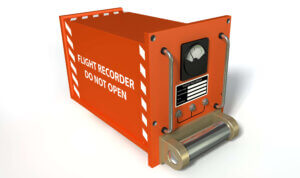Parallels in our workforce
The idea of failure or making errors, especially within healthcare has been misinterpreted as a weakness or worse still, feared because of grounds for disciplinary action. This element has been reflected upon in all areas of the healthcare industry but has it been truly embraced by all of us.
Reporting incidents is not a new concept but in terms of being positive for everyone’s benefit, this idea appears less obvious. Although better integrated into the surgical environment, there are still yawning gaps. Much has been learned from the world of aviation. Can podiatry learn from these examples that make up potential clinician reflection?

Preparing not to be surprised by the unexpected
What does thinking outside the box mean?
- The first part of the process is to be able to adapt to change. It is so easy to accept that routine is comfortable and a certain professional lethargy wraps around us like a python going in for the strangle hold. Unfortunately, health care and practice do not allow inertia despite the fact we reach an age where we believe we cannot improve.
- The second element requires that we review our practice from time to time and see if we can improve. Before you groan, take a step back and look at bite-size changes and review sections at a time. If in business (read private practice) are you bringing in new work? Is your income stationary? Do you feel the clientele you serve is happy?
- How do you bring this type of information into the viewfinder? If you do have a system in place that is good. It may be an audit system, or you keep a graph showing income trends, patient turnover, and a list of types of conditions.
- The third element of stepping back is to look in from a distance? Find out how you are performing. Do you notice problems or risks that have had consequences? Do you see achievements that have not reached their optimum outcome? Does a treatment you have used no longer work?

How do we see an apple? Something lost or something we have enjoyed?
We are now entering the maze of reflective practice. This can only work if what you see is what is real rather than what you believe you see. To think outside the box is to take a different approach to a problem
For the most part, the pathway for podiatry is gentle and might even appear infallible compared to medicine. This is no longer true as the ‘woke’ viewpoint has crept perniciously into society affecting our perception of what is right and what is unacceptable. Basic foot health and this could include foot health practitioners, could be exposed to complaints, litigation and threat. Reflection helps to dilute some of these problems.
In Matthew Syed’s book we read ‘Only by redefining failure will we unleash progress, creativity and resilience,’ He wrote his book on Black Box Thinking in 2015 and hammers home the value placed on teams working with respectful equality, unafraid to offer an opinion, Syed. The premise behind the title is simple and the examples used have been based on quality interviews, steeped in stories of aircraft accidents as well as health care mishaps. Syed does not confine himself to these subjects alone. Do the links with aircraft incidents have value to podiatry and her patients?
Aviation and health – the connect
 Learning from the data stored continues to be valuable after the event. However, the real value of the data can only come from sharing information openly without attributing blame. Beyond aviation, Syed points out, it is about creating a willingness to investigate the lessons and exploit their value.
Learning from the data stored continues to be valuable after the event. However, the real value of the data can only come from sharing information openly without attributing blame. Beyond aviation, Syed points out, it is about creating a willingness to investigate the lessons and exploit their value.
The act of trying to make a decision under pressure is regarded as an error of judgement. One case has been immortalised by the film industry, a film called ‘Sully’, in which the captain played by Tom Hanks ditches his plane in the Hudson River saving the lives of everyone. His tale was not over. The film concentrates on the aftermath and tells the harrowing story of how he faced criticism for making a decision that did not agree with his aviation board’s judgement based on simulated replay. The simulation (according to the film) excluded the human element which the aviation board failed to factor in.
 Faced with an HCPC case against five podiatrists (foot surgeons), all five were dismissed after being judged by non-foot surgeons and patients who had allegedly been persuaded by orthopaedic surgeons to take action. The fallibility of human decision making follows Captain Chesney (Sully) Sullenberger’s paradigm model of misjudgement. The cases were tried against the wrong standards i.e it turned out to be chiropody and with some, almost deliberate intent to indict those accused to satisfy that the system could cope. In 2022 the act of implementing annotation for surgeons corrected this lamentable injustice as all foot surgeons now have different standards against which better judgement and patient protection can be offered. However, the elephant in the room remains with inadequate numbers of foot surgeons who can advise the HCPC in such cases of poor practice.
Faced with an HCPC case against five podiatrists (foot surgeons), all five were dismissed after being judged by non-foot surgeons and patients who had allegedly been persuaded by orthopaedic surgeons to take action. The fallibility of human decision making follows Captain Chesney (Sully) Sullenberger’s paradigm model of misjudgement. The cases were tried against the wrong standards i.e it turned out to be chiropody and with some, almost deliberate intent to indict those accused to satisfy that the system could cope. In 2022 the act of implementing annotation for surgeons corrected this lamentable injustice as all foot surgeons now have different standards against which better judgement and patient protection can be offered. However, the elephant in the room remains with inadequate numbers of foot surgeons who can advise the HCPC in such cases of poor practice.
Making a judgement call under pressure will always require a degree of latitude otherwise we will see good professionals lose their license, depleting the workforce based on poor decision making
Time is a critical element often not available under pressure
The case of Emily Bromiley
Healthcare is no different from the Sully incident, especially when minutes, if not seconds, matter. Failing to achieve an adequate airway when a young mother presented for routine surgery under general anaesthetic irreversible brain damage followed. Fixated by time pressure lead doctors focused on a limited management protocol that failed to reverse events.
Seconds ticked away until there were no seconds left to secure cerebral re-oxygenation. Emily died two days later when vital opportunities were passed after an attending nurse suggested re-establishing her airway using a tracheostomy kit. The nurse failed to press her suggestion home as she felt that it was not her place to argue with those of higher status. Death followed days later. Two young children and a husband were left behind.
Few (podiatry) colleagues talk about failure and those that do often fail to embrace the positive side. The journey to reach success is predicated by the values of failure. Science is littered with examples and tales from Galen of Pergamon to Galileo Galilei and James Dyson to David Beckham, all beautifully told by Syed as valid examples. If we review our failures repeatedly, we can be stronger and eventually get it right. Perhaps this should justify the reason that history should remain on any educational curriculum, good and bad, heroic and cowardly.
Learning from failure
Dr Gary Kaplan observed that in a Japanese production plant any problem arising on the shop floor of a car factory could be interrupted without recourse to the so-called hierarchical framework. The lowest person in the chain could make a decision and was not penalised.
Kaplan saw the method used to make decisions on the shop floor of the Japanese factory as a transferable process in creating the concept of Patient Safety Alerts. Accidents and deaths were reduced in the Virginia Mason hospital by a staggering 74% improvement. The introduction of the WHO checks emerged both from black box thinking and from safety alerts, the latter came from the motor car industry.
In the UK this is turned into the well-known concept of health & safety protocols. Innovation comes from the success of learning about failure. Syed quotes Eleanor Roosevelt,
‘Learn from the mistakes of others. You can’t live long enough to make them yourself.‘
Until you embrace or if you prefer, recognise your own errors, it is unlikely that you will change.
Reflection within podiatry
While the case history I am describing next is ‘surgical’ it is an example of a process that could equally fit in with any new device or product that might fail.
In 1994 a new toe implant was developed by German orthopaedic surgeon, Dieter Werner and ceramic engineer Hans Jürgen Moje. After the first generation implant failed, the original screw fixation element was replaced with a press-fit design. The new properties of ceramic material was intended to replace the metal and silicone alternatives. The surgical community hoped that this new innovation might improve patient recovery and deliver long-lasting relief from first toe pain. Despite the development of a second-generation implant and early warnings, the prosthetic’s shiny white porcelain-like material was promoted.
Brewster et al (2010) reviewed his earlier comments based on clinical cases and ‘Based on these (32 joint replacements) results, we concluded that first MTPJ total joint replacement with the Moje device remains promising, but still has room for improvement before the results match those obtained with larger joint (knee, hip) arthroplasty.’
Timeline is an important period required for reflection
Brewster’s review was a dispassionate piece of reporting, but taken in isolation meant little. The clinical numbers were low and revision of 2 implants occurred between 41-63 months. Taken as an acceptable feature of any foot surgery, this might not appear bad. However, the two surgical foot professions (orthopaedic and podiatric) were not only slow to respond but failed to produce an alert in 2001 by this author and another senior foot surgeon.
Success can arise before failure
In 2004 Malviya et al extolled the joint’s virtue, and stated…
“The implant has been tolerated well by all the patients. It seems to be an improvement over the previous design and is a good and relatively simple procedure with gratifying results. While the Moje Pressfit Ceramic implant may not be a final answer, our review does show that it is a reasonable and acceptable option when replacement of the first metatarsophalangeal joint is being considered. A long-term follow-up with a larger series of patients is obviously desirable before arriving at a final conclusion.‘
But, the implant was not a simple procedure although it provided an impression of ease because of the press-fit design. Incorrect alignment would go on to have irredeemable results.
Early warnings ignored
A hint of concern appeared in published form from Barwick in 2008.
‘There is an unacceptably high incidence of failure of the press-fit Moje implant and we do not recommend its use. Patients who already have this implant in situ should have regular radiographic surveillance.’ Nixon (2008) ‘This implant offers less reliable outcomes than the ‘gold standard’ arthrodesis and one would advise caution regarding its use for osteoarthritis of the first MTPJ.’
More findings started to emerge
Another reflective article from Mathias Nagy reported – ‘The results of second-generation ceramic first MP joint replacement in our series demonstrated poor clinical and radiological results with a high revision rate.’ M.T. Nagy et al (2014), and went on to say, ‘The results in our series demonstrated poor clinical and radiological results with a high revision rate. The replacement failed to preserve the function of the joint and the range of movement was limited in most cases. … we do not recommend the routine use of this prosthesis and all patients who have this type of prosthesis need regular follow-up consultations at least yearly with weight-bearing radiographs to assess the position of the implant.’
It is often not possible to reflect adequately until a period of time has passed. Until this point, we have to remain vigilant and critique all our treatment.
The real take-home feature is that in medical health care we are given products to use that cannot hope to be tested properly until used on humans. Who in fact is the guinea pig? It is both patient and clinician. This is not the only example but it is one that has a good trail of post-development feedback. It took 8 years before anyone took any notice. Even today NICE has no red flag posted on the Moje and their great toe implant advice dates to November 2005 (checked 16/5/22).
Elaine Bromiley should have the final word
Emily’s family was left without a mother following brain death. Martin Bromiley, a pilot, worked hard to share the incident based on the evidence he had finally uncovered. This was reluctantly admitted and many anaesthetists around the world thanked him for recognising that the real problem did not lie with clinician incompetence or negligence but factors that overtook human nature.
Had they listened to the nurse, who herself felt she could not question her consultants, then Elaine would be alive today. Thinking outside the box means taking lessons from areas that are not immediately related. Find a core theme and common denominator and apply the learning. Do this and you have quality reflection and action.

Other reflection articles by the same author at ConsultingFootPain
- Original Reflective Articles
- Reflection from workshops and meetings
- The value of Podiatric Reflective Practice
Thanks for reading ‘Good Clinicians think outside the box’ by David R Tollafield
Sign-up for here my regular FREE newsfeed
Published by Busypencilcase Reflective Communications Est. 2015
Original article February 2019. Updated 16 May 2022



Recent Comments